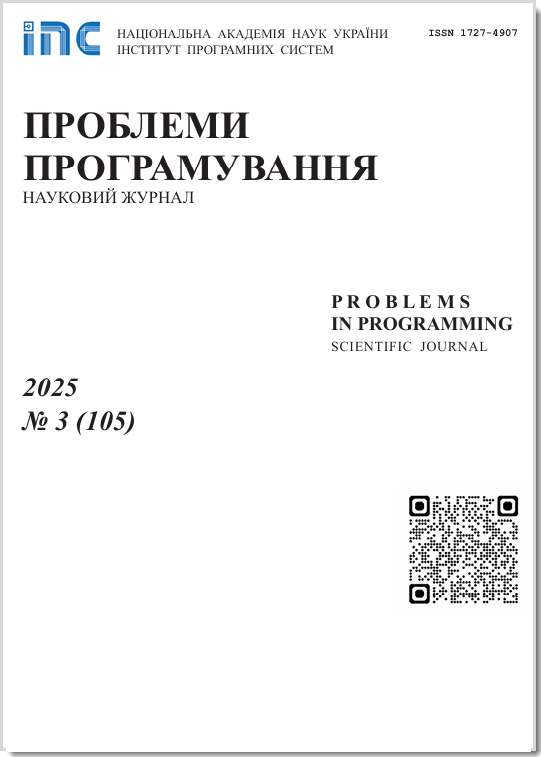Mathematical foundations for designing and development of intelligent systems of information analysis
Abstract
This article is an attempt to combine different ways of working with sets of objects and their classes for designing and development of artificial intelligent systems (AIS) of analysis information, using object-oriented programming (OOP). This paper contains analysis of basic concepts of OOP and their relation with set theory and artificial intelligence (AI). Process of sets and multisets creation from different sides, in particular mathematical set theory, OOP and AI is considered. Definition of object and its properties, homogeneous and inhomogeneous classes of objects, set of objects, multiset of objects and constructive methods of their creation and classification are proposed. In addition, necessity of some extension of existing OOP tools for the purpose of practical implementation AIS of analysis information, using proposed approach, is shown.
Prombles in programming 2014; 2-3: 233-241
Full Text:
PDFReferences
http://langpop.com/ Programming Language Popularity.
http://www.tiobe.com/ TIOBE Programming Community Index.
http://lang-index.sourceforge.net/ The Transparent Language Popularity Index.
Weisfeld M. The Object-Oriented Thought Process. Third Edition. Addison-Wesley Professional, 2008.
Pecinovský R. OOP – Learn Object Oriented Thinking and Programming. Tomáš Bruckner, Řepín-Živonín, 2013.
Slagle J.R. Artificial intelligence: The Heuristic Programming Approach. McGRAW-HILL Book Company, 1971.
Coppin B. Artificial intelligence illuminated. Jones and Bartlett Publishers, Inc. 2004.
Konar A. Artificial Intelligence and Soft Computing. Behavioral and Cognitive Modeling of the Human Brain. CRC Press LLC, 2000.
Rabunal J.R., Dorado J., Pazos A. Encyclopedia of Artificial Intelligence. Information Science Reference, 2008.
Luger G.F. Artificial Intelligence. Structures and Strategies for Complex Problem Solving: 6-th edition. Addison-Wesley, 2008.
Jones M.T. Artificial Intelligence: A Systems Approach. Infinity Science Press LLC, 2008.
Handbook of Artificial Intelligence Book 2: Models and Methods, edited by D. A. Pospelov. – Moscow, “Radio i Sviaz” 1990.
Ruchkin V.N., Fulin V.A. Universal Artificial Intelligence and Expert Systems. St. Petersburg: "BHV-Petersburg", 2009.
Ginsberg M. Essentials of artificial intelligence. Morgan Kaufmann Publishers, Inc., 1993.
Cantor G. Contributions to the Founding of the Theory of Transfinite Numbers. – New York: Dover Publications, Inc., 1915.
Wang H. and Naughton R.M. Les Systemes Axiomatiques de la Theorie des Ensembles. – Paris: Gauthier-Villars, 1953.
Vopenka P. Mathematics in the alternative set theory. Leipzig: BSB B.G. Teubner, 1979.
Zadeh L.A. Fuzzy sets. Information and control. – 1965, N 8, P. 338–353.
Stroustrup B. The C++ Programming Language: Special Edition. Addison-Wesley Professional, 2000.
Eckel B. Thinking in Java: 4-th Edition. Prentice Hall. – 2006.
Kurosh A.G. Lectures on general algebra: Second Edition. – Moscow: Nauka, 1973.
Serhienko I.V., Kryvyi S.L., and Provotar O.I. Algebraic Aspects of Information Technology. – Kyiv: Naukova Dumka, 2011.
Stoll R.R. Sets, Logic and Axiomatic Theories: 2-nd edition. W.H. Freeman & Co Ltd. 1975.
http://cglib.sourceforge.net/ Code Generation Library CGLib.
http://msdn.microsoft.com/en-us/library/650ax5cx.aspx Code Document Object Model.
Musser D.R., Derge G.J., Saini A. STL Tutorial and Reference Guide: 2-nd edition. C++ Programming with the Standard Template Library, Addison-Wesley Professional, 2001.
Mukherjee S. NET 4.0 Generics: Beginner’s Guide. Packt Publishing Ltd. 2012.
Summerfield M. Programming in Python 3. A Complete Introduction to the Python Language: 2-nd edition. Pearson Education, Inc. 2010.
Bruijn N.D. Denumerations of rooted trees and multisets // Discrete Applied Mathematics. – 1983. – Vol. 6, N 1. – P. 25–33.
Syropoulos A. Mathematics of multisets, in Proceedings of the Workshop on Multiset Processing: Multiset Processing, Mathematical, Computer Science, and Molecular Computing Points of View”, Springer-Verlag Berlin Heidelberg, 2001. – P. 347–358.
Petrovskyi A. Spaces of sets and multisets. M.: Editorial URSS, 2003.
Refbacks
- There are currently no refbacks.








